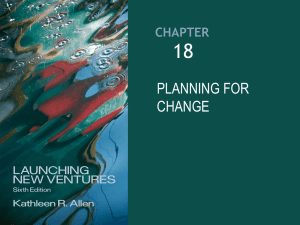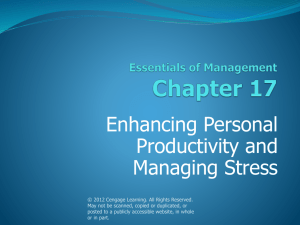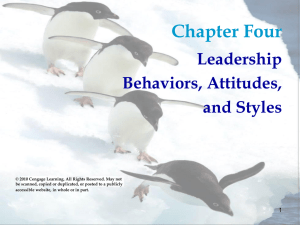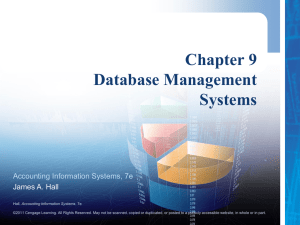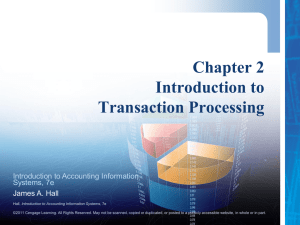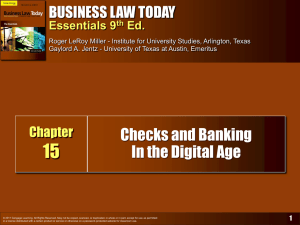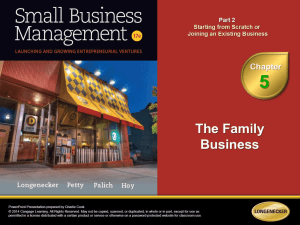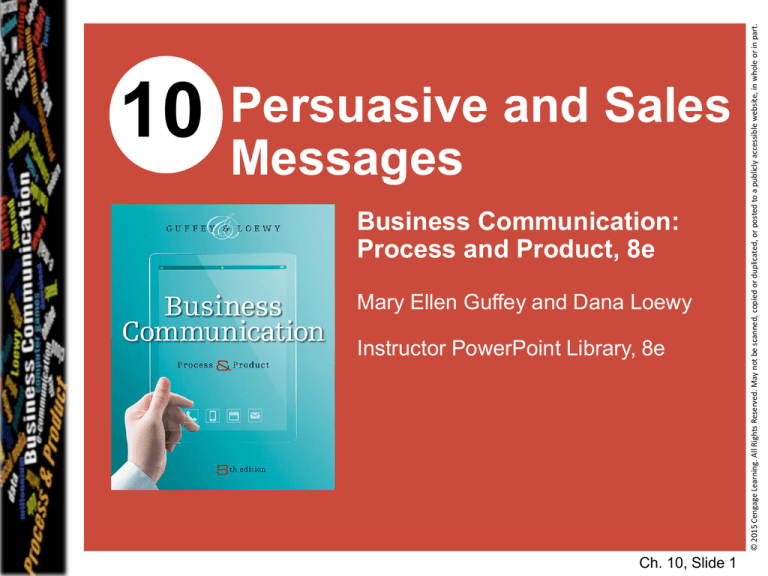
Business Communication:
Process and Product, 8e
Mary Ellen Guffey and Dana Loewy
Instructor PowerPoint Library, 8e
Ch. 10, Slide 1
© 2015 Cengage Learning. All Rights Reserved. May not be scanned, copied or duplicated, or posted to a publicly accessible website, in whole or in part.
10
Persuasive and Sales
Messages
© 2015 Cengage Learning. All Rights Reserved. May not be scanned, copied or duplicated, or posted to a publicly accessible website, in whole or in part.
Learning Objective 1
Explain digital-age persuasion,
identify effective persuasive
techniques, and apply the 3-x-3
writing process to persuasive
messages in print and online.
Ch. 10, Slide 2
Persuasive skills are
ever more important:
• Leaner corporate
hierarchies
• Blurring lines of
authority
• Reliance on teams
• Savvy, well-informed
consumers
Many managers try to
influence others
instead of issuing
commands.
Ch. 10, Slide 3
© 2015 Cengage Learning. All Rights Reserved. May not be scanned, copied or duplicated, or posted to a publicly accessible website, in whole or in part.
© denis_pc/Fotolia
Understanding Persuasion in
the Digital Age
Persuasion is “a symbolic process in
which communicators try to convince
other people to change their attitudes
or behaviors regarding an issue
through the transmission of a message
in an atmosphere of free choice.”
-- Richard M. Perloff
Ch. 10, Slide 4
© 2015 Cengage Learning. All Rights Reserved. May not be scanned, copied or duplicated, or posted to a publicly accessible website, in whole or in part.
What is Persuasion?
Is a symbolic
process
Involves an attempt
to influence
Involves
transmitting a
message
Is self-persuasion
Requires free
choice
Ch. 10, Slide 5
© 2015 Cengage Learning. All Rights Reserved. May not be scanned, copied or duplicated, or posted to a publicly accessible website, in whole or in part.
© leremy/Fotolia
Perloff’s Five Components of
Persuasion
Reciprocation
Liking
Commitment
Authority
Social Proof
Scarcity
Ch. 10, Slide 6
© 2015 Cengage Learning. All Rights Reserved. May not be scanned, copied or duplicated, or posted to a publicly accessible website, in whole or in part. ©
leremy/Fotolia
Six Basic Principles That Direct
Human Behavior
• The volume and reach of
persuasive messages have
exploded.
• Persuasive messages spread at
warp speed.
• Organizations of all stripes are in
the persuasion business.
• Persuasive techniques are more
subtle and misleading.
• Persuasion is more complex and
impersonal.
Ch. 10, Slide 7
© 2015 Cengage Learning. All Rights Reserved. May not be scanned, copied or duplicated, or posted to a publicly accessible website, in whole or in part.
© Marina Zlochin/Fotolia
How Has Persuasion Changed
in the Digital Age?
Establishing
credibility
Making a
reasonable,
specific request
Tying facts to
benefits
Recognizing the
power of loss
Expecting and
overcoming
resistance
Sharing
solutions and
compromising
Ch. 10, Slide 8
© 2015 Cengage Learning. All Rights Reserved. May not be scanned, copied or duplicated, or posted to a publicly accessible website, in whole or in part.
© denis_pc/Fotolia
Effective Persuasion
Techniques
Phase 1: Analyze,
Anticipate, Adapt
What do you want the receiver
to do or think?
Does the receiver need to be
persuaded?
How can you adapt your
message to appeal to this
receiver?
Ch. 10, Slide 9
© 2015 Cengage Learning. All Rights Reserved. May not be scanned, copied or duplicated, or posted to a publicly accessible website, in whole or in part.
Applying the 3-x-3 Writing Process
to Persuasive Messages
Phase 2: Research,
Organize, Compose
What information do you
need? Where can you locate
it?
Which strategy is better –
direct or indirect?
Ch. 10, Slide 10
© 2015 Cengage Learning. All Rights Reserved. May not be scanned, copied or duplicated, or posted to a publicly accessible website, in whole or in part.
Applying the 3-x-3 Writing Process
to Persuasive Messages
Phase 3: Revise,
Proofread, Evaluate
Is the message clear and
concise?
Is the message conversational?
Are format, grammar, and
mechanics correct?
Will the message achieve its
purpose?
Ch. 10, Slide 11
© 2015 Cengage Learning. All Rights Reserved. May not be scanned, copied or duplicated, or posted to a publicly accessible website, in whole or in part.
Applying the 3-x-3 Writing Process
to Persuasive Messages
Describe the traditional four-part
AIDA strategy for creating successful
persuasive messages, and apply the
four elements to effective and ethical
business messages.
Ch. 10, Slide 12
© 2015 Cengage Learning. All Rights Reserved. May not be scanned, copied or duplicated, or posted to a publicly accessible website, in whole or in part.
Learning Objective 2
Attention
Interest
Desire
Action
© 2015 Cengage Learning. All Rights Reserved. May not be scanned, copied or duplicated, or posted to a publicly accessible website, in whole or in part.
Persuading With AIDA
Ch. 10, Slide 13
1
Summary of
problem
2
Unexpected
statement
3
Reader benefit
Ch. 10, Slide 14
© 2015 Cengage Learning. All Rights Reserved. May not be scanned, copied or duplicated, or posted to a publicly accessible website, in whole or in part.
AIDA – Gaining Attention
4
Compliment
5
Related facts
6
Stimulating
question
Ch. 10, Slide 15
© 2015 Cengage Learning. All Rights Reserved. May not be scanned, copied or duplicated, or posted to a publicly accessible website, in whole or in part.
AIDA – Gaining Attention
1
Facts, figures
2
Expert opinions
3
Examples
Ch. 10, Slide 16
© 2015 Cengage Learning. All Rights Reserved. May not be scanned, copied or duplicated, or posted to a publicly accessible website, in whole or in part.
AIDA – Building Interest
4
Specific details
5
Direct benefits
6
Indirect benefits
Ch. 10, Slide 17
© 2015 Cengage Learning. All Rights Reserved. May not be scanned, copied or duplicated, or posted to a publicly accessible website, in whole or in part.
AIDA – Building Interest
1
Reduce resistance
2
Anticipate
objections
3
Offer
counterarguments
Ch. 10, Slide 18
© 2015 Cengage Learning. All Rights Reserved. May not be scanned, copied or duplicated, or posted to a publicly accessible website, in whole or in part.
AIDA – Eliciting Desire
4
Use What if?
scenarios
5
Demonstrate
competence
6
Show value of
proposal
© 2015 Cengage Learning. All Rights Reserved. May not be scanned, copied or duplicated, or posted to a publicly accessible website, in whole or in part.
AIDA – Eliciting Desire
Ch. 10, Slide 19
1
Describe specific
request
2
Sound confident
3
Make action easy
to take
Ch. 10, Slide 20
© 2015 Cengage Learning. All Rights Reserved. May not be scanned, copied or duplicated, or posted to a publicly accessible website, in whole or in part.
AIDA – Prompting Action
4
Offer incentive or
gift
5
Don’t provide
excuses
6
Repeat main
benefits
Ch. 10, Slide 21
© 2015 Cengage Learning. All Rights Reserved. May not be scanned, copied or duplicated, or posted to a publicly accessible website, in whole or in part.
AIDA – Prompting Action
Build Credibility:
1
2
Be truthful and
believable.
3
Don’t
manipulate or
mislead.
Stick to the facts
and don’t
exaggerate.
4
Don’t omit
crucial
information.
5
Don’t provide
deceptive
emphasis.
Ch. 10, Slide 22
© 2015 Cengage Learning. All Rights Reserved. May not be scanned, copied or duplicated, or posted to a publicly accessible website, in whole or in part.
Being an Ethical Persuader
Craft persuasive messages that
request actions, make claims, and
deliver complaints.
Ch. 10, Slide 23
© 2015 Cengage Learning. All Rights Reserved. May not be scanned, copied or duplicated, or posted to a publicly accessible website, in whole or in part.
Learning Objective 3
Prewrite
Determine your purpose. Know exactly what
you want to achieve. Anticipate the reaction of
your audience. Remember that the receiver is
thinking:
Why
should I?
What’s
in it for
me?
What’s
in it for
you?
Who
cares?
Ch. 10, Slide 24
© 2015 Cengage Learning. All Rights Reserved. May not be scanned, copied or duplicated, or posted to a publicly accessible website, in whole or in part.
© Ogerepus/Fotolia
Using the AIDA Strategy in
Requests, Claims, and Complaints
Gain Attention
• Use the indirect strategy rather than blurting
out the request immediately.
• Begin with a problem description, unexpected
statement, reader benefit, compliment, related
facts, or stimulating question to grab attention.
Ch. 10, Slide 25
© 2015 Cengage Learning. All Rights Reserved. May not be scanned, copied or duplicated, or posted to a publicly accessible website, in whole or in part.
© Ogerepus/Fotolia
Using the AIDA Strategy in
Requests, Claims, and Complaints
Build Interest
• Convince the audience that your
request is reasonable.
• Develop interest by using facts,
statistics, examples,
testimonials, and specific details.
• Establish your credibility, if
necessary, by explaining your
background and expertise. Use
testimonials, expert opinions, or
research if necessary.
Ch. 10, Slide 26
© 2015 Cengage Learning. All Rights Reserved. May not be scanned, copied or duplicated, or posted to a publicly accessible website, in whole or in part.
© Ogerepus/Fotolia
Using the AIDA Strategy in
Requests, Claims, and Complaints
Build Interest
• Support your request by tying
facts to direct benefits (increased
profits, more efficient operations,
better customer relations, saving
money, a returned favor) or
indirect benefits (improving the
community, giving back to the
profession, helping the
environment).
• In claims and complaints, be
objective but prove the validity of
your request.
Ch. 10, Slide 27
© 2015 Cengage Learning. All Rights Reserved. May not be scanned, copied or duplicated, or posted to a publicly accessible website, in whole or in part.
Using the AIDA Strategy in
Requests, Claims, and Complaints
Elicit Desire and Reduce Resistance
• Anticipate objections to your request by using
What if? scenarios and provide compelling
counterarguments.
• Demonstrate credibility and competence.
• In claims and complaints, use a moderate,
unemotional tone.
What
if…?
Ch. 10, Slide 28
© 2015 Cengage Learning. All Rights Reserved. May not be scanned, copied or duplicated, or posted to a publicly accessible website, in whole or in part.
© Ogerepus/Fotolia
Using the AIDA Strategy in
Requests, Claims, and Complaints
Motivate Action
• Make a precise request that spells
out exactly what you want done.
• Add a deadline date if necessary.
• Repeat a key benefit, provide
additional details, or offer an
incentive. Express appreciation.
• Be confident without seeming
pushy.
Ch. 10, Slide 29
© 2015 Cengage Learning. All Rights Reserved. May not be scanned, copied or duplicated, or posted to a publicly accessible website, in whole or in part.
© Ogerepus/Fotolia
Using the AIDA Strategy in
Requests, Claims, and Complaints
Direct Benefit:
If you accept
our invitation to
speak, you will
have an
audience of 50
potential
customers for our
products.
Indirect Benefit:
Your
appearance
would prove your
professionalism
and make us
grateful for your
willingness to
give something
back to the
profession.
Ch. 10, Slide 30
© 2015 Cengage Learning. All Rights Reserved. May not be scanned, copied or duplicated, or posted to a publicly accessible website, in whole or in part.
© denis_pc/Fotolia
Focusing on Benefits in
Persuasive Requests
Dear Dr. Thomas:
Because you know Atlanta and live here in our town, we thought about asking you
to speak at our GSU Business Awards banquet April 28.
A few students on campus have read and admired your book Beyond Race and
Gender, which appeared last spring and became a bestseller across the nation. We
were amazed that a local author is now the nation’s diversity management guru.
But what exactly did you mean when you said that America is no longer a melting
pot of ethnic groups—it’s an “American mulligan stew”?
Georgia State University doesn’t have any funds for honoraria, so we can invite
only local speakers. The Reverend James R. Jones and Vice Mayor Rebecca A.
Timmons were speakers in the past. Our awards banquet gets started at 6 p.m.
with a social hour, followed by dinner at 7 and the speaker from 8:30 until 9. If
you require, we can arrange transportation for you and your guest.
Although you are a very busy person, we hope you will agree to this invitation.
Thank you in advance. Please notify our advisor, Professor Alexa North.
Sincerely yours,
Ch. 10, Slide 31
© 2015 Cengage Learning. All Rights Reserved. May not be scanned, copied or duplicated, or posted to a publicly accessible website, in whole or in part.
“Before” – Ineffective Request
Dear Dr. Thomas:
Your book Beyond Race and Gender stimulated provocative discussion across the
nation and on our campus when it first appeared last spring.
Business students at Georgia State University now consider you the nation’s
diversity management guru, and for that reason they asked me to use all my
powers of persuasion in this invitation. Because we admire your work, we would
like you to be our keynote speaker at the GSU Business Awards banquet April 28.
As students at an urban campus in a metropolitan area, we are keenly aware of
diversity issues. In your words, America is no longer a melting pot of ethnic
groups; it is now an “American mulligan stew.” We would like to hear more about
the future workforce and how managers can maximize the contribution of all
employees.
Although we can’t offer you an honorarium, we can promise you a fine dinner at
the GSU Faculty Club and an eager and appreciative audience of over 100
business students and faculty. Speakers in the past have included the Reverend
James R. Jones and Vice Mayor Rebecca A. Timmons.
Ch. 10, Slide 32
© 2015 Cengage Learning. All Rights Reserved. May not be scanned, copied or duplicated, or posted to a publicly accessible website, in whole or in part.
“After” – Improved Request
Dr. Thomas
Page 2
Current date
The evening includes a social hour at 6 p.m., dinner at 7 p.m., and your
remarks from 8:30 until 9. So that you won’t have to worry about
transportation or parking, we will arrange a limousine for you and your guest.
Please make this our most memorable banquet yet. Just call our adviser,
Professor Alexa North, at 356-9910 before April 5 to accept this invitation.
Sincerely yours,
Ch. 10, Slide 33
© 2015 Cengage Learning. All Rights Reserved. May not be scanned, copied or duplicated, or posted to a publicly accessible website, in whole or in part.
“After” – Improved Request (continued)
Understand interpersonal persuasion
at work and write persuasive
messages within organizations.
Ch. 10, Slide 34
© 2015 Cengage Learning. All Rights Reserved. May not be scanned, copied or duplicated, or posted to a publicly accessible website, in whole or in part.
Learning Objective 4
Managers no
longer serve as
primary
information
providers.
Many
supervisors view
themselves as
collaborators
and mentors.
Executives
increasingly rely
on persuasion to
achieve buy-in
from
subordinates.
Ch. 10, Slide 35
© 2015 Cengage Learning. All Rights Reserved. May not be scanned, copied or duplicated, or posted to a publicly accessible website, in whole or in part.
© denis_pc/Fotolia, © denis_pc/Fotolia, © Andrey/Fotolia
Persuasion in Digital-Age
Organizations
Shift in authority is affecting the
strategies and tone of workplace
persuasive messages.
Ch. 10, Slide 36
© 2015 Cengage Learning. All Rights Reserved. May not be scanned, copied or duplicated, or posted to a publicly accessible website, in whole or in part.
© denis_pc/Fotolia, © denis_pc/Fotolia, © Andrey/Fotolia
Persuasion in Digital-Age
Organizations
Persuasive requests may
include the following:
• Participating in volunteer
projects
• Joining programs to stop
smoking, lose weight, or start
exercising
Ch. 10, Slide 37
© 2015 Cengage Learning. All Rights Reserved. May not be scanned, copied or duplicated, or posted to a publicly accessible website, in whole or in part.
© denis_pc/Fotolia
Persuading Employees: Messages
Flowing Downward
Instructions or directives moving
downward from supervisors
usually require little persuasion.
BUT:
Paying attention to tone is
necessary.
Ch. 10, Slide 38
© 2015 Cengage Learning. All Rights Reserved. May not be scanned, copied or duplicated, or posted to a publicly accessible website, in whole or in part.
© denis_pc/Fotolia
Persuading Employees: Messages
Flowing Downward
• Focus on evidence such as
facts and figures.
• If possible, quantify the
benefits of your idea in dollar
terms.
• Be confident and even-handed
when pitching your idea.
Ch. 10, Slide 39
© 2015 Cengage Learning. All Rights Reserved. May not be scanned, copied or duplicated, or posted to a publicly accessible website, in whole or in part.
© denis_pc/Fotolia
Persuading the Boss: Messages
Flowing Upward
BUT:
Be sensitive to tone; use words
such as suggest and
recommend, not you must or we
should.
Ch. 10, Slide 40
© 2015 Cengage Learning. All Rights Reserved. May not be scanned, copied or duplicated, or posted to a publicly accessible website, in whole or in part.
© denis_pc/Fotolia
Persuading the Boss: Messages
Flowing Upward
Create effective and ethical directmail and e-mail sales messages.
Ch. 10, Slide 41
© 2015 Cengage Learning. All Rights Reserved. May not be scanned, copied or duplicated, or posted to a publicly accessible website, in whole or in part.
Learning Objective 5
Prewrite: Analyze your product
or service.
1
What makes it special?
2
What central points should
you emphasize?
3
How does it compare with
the competition?
Ch. 10, Slide 42
© 2015 Cengage Learning. All Rights Reserved. May not be scanned, copied or duplicated, or posted to a publicly accessible website, in whole or in part.
© dashadima/Fotolia.com
Creating Persuasive
Sales Messages in Print and Online
Prewrite: Profile your audience.
1
How will this product or
service benefit the
audience?
2
What do you want the
audience to do?
Increase the response rate by
targeting your audience through
selected database mailing lists.
Ch. 10, Slide 43
© 2015 Cengage Learning. All Rights Reserved. May not be scanned, copied or duplicated, or posted to a publicly accessible website, in whole or in part.
© dashadima/Fotolia.com
Creating Persuasive
Sales Messages in Print and Online
Gain Attention
1
Describe a product
feature, present
testimonials, make a
startling statement, or
show the reader in an
action setting.
Ch. 10, Slide 44
© 2015 Cengage Learning. All Rights Reserved. May not be scanned, copied or duplicated, or posted to a publicly accessible website, in whole or in part.
© dashadima/Fotolia.com
Creating Persuasive
Sales Messages in Print and Online
Gain Attention
2
Offer something
valuable, promise a
significant result, or
describe a product
feature.
Ch. 10, Slide 45
© 2015 Cengage Learning. All Rights Reserved. May not be scanned, copied or duplicated, or posted to a publicly accessible website, in whole or in part.
© dashadima/Fotolia.com
Creating Persuasive
Sales Messages in Print and Online
Gain Attention
3
Suggest a solution to a
problem, offer a
relevant anecdote, use
the receiver’s name, or
mention a meaningful
current event.
Ch. 10, Slide 46
© 2015 Cengage Learning. All Rights Reserved. May not be scanned, copied or duplicated, or posted to a publicly accessible website, in whole or in part.
© dashadima/Fotolia.com
Creating Persuasive
Sales Messages in Print and Online
Build Interest
1
Describe the product in
terms of what it does
for the reader: Show
how the product or
service saves or makes
money, reduces effort,
improves health,
produces pleasure, or
boosts status.
Ch. 10, Slide 47
© 2015 Cengage Learning. All Rights Reserved. May not be scanned, copied or duplicated, or posted to a publicly accessible website, in whole or in part.
© Petr Vaclavek/Fotolia
Creating Persuasive
Sales Messages in Print and Online
Elicit Desire, Reduce Resistance
1
Counter anticipated
reluctance with
attractive warranties,
trial offers, free
samples, money-back
guarantees, or
testimonials.
Ch. 10, Slide 48
© 2015 Cengage Learning. All Rights Reserved. May not be scanned, copied or duplicated, or posted to a publicly accessible website, in whole or in part.
© dashadima/Fotolia.com
Creating Persuasive
Sales Messages in Print and Online
Elicit Desire, Reduce Resistance
2
Build credibility with
results of performance
tests, polls, or awards.
3
If price is not a selling
feature, describe it in
small units, show it as
savings, or tell how it
compares favorably
with the competition.
Ch. 10, Slide 49
© 2015 Cengage Learning. All Rights Reserved. May not be scanned, copied or duplicated, or posted to a publicly accessible website, in whole or in part.
© leremy/Fotolia
Creating Persuasive
Sales Messages in Print and Online
Motivate Action
1
2
Close by repeating a
central selling point
with clear instructions
for easy action.
Prompt the reader to
act immediately with a
gift, incentive, limited
offer, or deadline.
Ch. 10, Slide 50
© 2015 Cengage Learning. All Rights Reserved. May not be scanned, copied or duplicated, or posted to a publicly accessible website, in whole or in part.
© dashadima/Fotolia.com
Creating Persuasive
Sales Messages in Print and Online
Motivate Action
3
Put the strongest
motivator in a
postscript.
4
Make it easy to
respond.
5
In e-mails, include an
opportunity to opt out.
Ch. 10, Slide 51
© 2015 Cengage Learning. All Rights Reserved. May not be scanned, copied or duplicated, or posted to a publicly accessible website, in whole or in part.
© dashadima/Fotolia.com
Creating Persuasive
Sales Messages in Print and Online
Some Characteristics
1
Direct mail offers
a higher
response rate
than e-mail.
2
Direct mail can be
personalized and
carries a more
complete
message.
3
Direct mail is
expensive
compared to
e-mail.
Ch. 10, Slide 52
© 2015 Cengage Learning. All Rights Reserved. May not be scanned, copied or duplicated, or posted to a publicly accessible website, in whole or in part.
© raven/Fotolia
Direct Mail or E-Mail?
© 2015 Cengage Learning. All Rights Reserved. May not be scanned, copied or duplicated, or posted to a publicly accessible website, in whole or in part.
Direct Mail or E-Mail?
Some Characteristics
4
E-mail is the
No. 1 marketing
medium, ahead
of direct mail.
5
E-marketers can
distribute a
promotion faster
than traditional
messages.
Ch. 10, Slide 53
1
Craft a catchy subject
line.
2
Keep the main
information “above the
fold.”
3
Make the message
short, conversational,
and focused.
Ch. 10, Slide 54
© 2015 Cengage Learning. All Rights Reserved. May not be scanned, copied or duplicated, or posted to a publicly accessible website, in whole or in part.
© leremy/Fotolia
Writing Successful E-Mail
Sales Messages
4
Convey urgency.
5
Sprinkle testimonials
throughout the copy.
6
Provide a means for
opting out.
Ch. 10, Slide 55
© 2015 Cengage Learning. All Rights Reserved. May not be scanned, copied or duplicated, or posted to a publicly accessible website, in whole or in part.
© leremy/Fotolia
Writing Successful E-Mail
Sales Messages
1
2
Business communicators
use social media to
promote their
businesses, further their
causes, and build their
online personas—not
primarily for overt
selling.
Many of the principles of
persuasion also apply to
micromessages (online
posts or tweets) although
only parts of the AIDA
strategy may be used.
Ch. 10, Slide 56
© 2015 Cengage Learning. All Rights Reserved. May not be scanned, copied or duplicated, or posted to a publicly accessible website, in whole or in part.
© denis_pc/Fotolia
Writing Short Persuasive
Messages Online
Updates of
events,
experiences,
thoughts, and
exploits
Promotional
offers such as
an invitation to
participate in
games
Announcements
of interesting
events,
publications,
and media links
Ch. 10, Slide 57
© 2015 Cengage Learning. All Rights Reserved. May not be scanned, copied or duplicated, or posted to a publicly accessible website, in whole or in part.
© denis_pc/Fotolia
Types of Persuasive Posts
and Tweets
Apply basic techniques in developing
persuasive press releases.
Ch. 10, Slide 58
© 2015 Cengage Learning. All Rights Reserved. May not be scanned, copied or duplicated, or posted to a publicly accessible website, in whole or in part.
Learning Objective 6
Press (news)
releases announce
important information
to the media,
traditional or digital:
new products
management changes
new facilities
sponsorships
community projects
awards given or
received
joint ventures
donation
seminars
demonstrations
Ch. 10, Slide 59
© 2015 Cengage Learning. All Rights Reserved. May not be scanned, copied or duplicated, or posted to a publicly accessible website, in whole or in part.
© denis_pc/Fotolia, © alexmillos/Fotolia.com, © Andrey/Fotolia
What Are Press Releases?
Organizations hope
that the media will pick
up the news and
provide good publicity.
BUT:
Purely self-serving or
promotional
information is not
appealing to editors
and producers.
Ch. 10, Slide 60
© 2015 Cengage Learning. All Rights Reserved. May not be scanned, copied or duplicated, or posted to a publicly accessible website, in whole or in part.
© denis_pc/Fotolia, © alexmillos/Fotolia.com, © Andrey/Fotolia
The Purpose of Press Releases
Open with an
attention-getting
lead or a
summary of the
important facts.
Include answers
to the five Ws
and one H (who,
what, when,
where, why, and
how) in the
article—but not
all in the first
sentence!
Appeal to the
audience of the
target media.
Emphasize
reader benefits
written in the
style of the focus
publication or
newscast.
Ch. 10, Slide 61
© 2015 Cengage Learning. All Rights Reserved. May not be scanned, copied or duplicated, or posted to a publicly accessible website, in whole or in part.
© alexmillos/Fotolia.com, © denis_pc /Fotolia
Developing Persuasive
Press Releases
Present the most
important information
early, followed by
supporting information.
Don’t put your best ideas
last because the may be
chopped off or ignored.
Insert intriguing and
informative quotations of
chief decision makers to
lend the news release
credibility.
Ch. 10, Slide 62
© 2015 Cengage Learning. All Rights Reserved. May not be scanned, copied or duplicated, or posted to a publicly accessible website, in whole or in part.
© denis_pc/Fotolia
Developing Persuasive
Press Releases
Make the document
readable and visually
appealing. Limit the text
to one or two doublespaced pages with
attractive formatting.
Look and sound
credible—no typos, no
imaginative spelling or
punctuation, no factual
errors.
Ch. 10, Slide 63
© 2015 Cengage Learning. All Rights Reserved. May not be scanned, copied or duplicated, or posted to a publicly accessible website, in whole or in part.
© denis_pc/Fotolia
Developing Persuasive
Press Releases
© 2015 Cengage Learning. All Rights Reserved. May not be scanned, copied or duplicated, or posted to a publicly accessible website, in whole or in part.
© alexmillos/Fotolia.com
END
Ch. 10, Slide 64

